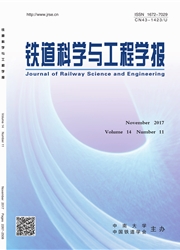

 中文摘要:
中文摘要:
为保证有轨电车快速和准点的优势,通常采用绿波控制协调各信号灯的相位差,使有轨电车在交叉口间按规定时间运行时能连续获得绿灯。然而,目前编制时刻表时一般未考虑列车在车站启停操纵引起的时间损失,导致列车赶点运行而增加牵引时间甚至遇上红灯,从而导致牵引能耗增加。以总牵引能耗最小为目标,建立时刻表和列车操纵双层节能优化模型。上层为有轨电车在各交叉口间运行时间的优化调整模型,下层为列车在给定运行时间下的节能操纵模型。同时,设计相应的双层遗传算法进行求解。研究结果表明:通过该方法可以在总运行时间不变的情况下减少超过16.5%的牵引能耗。
 英文摘要:
英文摘要:
Green wave control,which is to allow continuous traffic flow over several intersections in one direction,has been widely used in tram operation to guarantee its advantages of high-speed and reliability.However,previous studies did not take into account the time loss caused by tram stopping at the stations in timetabling.In such cases,it may lead to the increase of traction time to catch up with the schedule or even make the tram stop at intersections for a red light.Thus,it results in more energy consumption for tram operation.In this paper,a bilevel optimization model involving both timetable and tram control was built for energy saving.The upper layer was to adjust the running time distributed in different intersections along the journey,while the lower layer is to attain the energy-efficient control scheme of tram movement.Genetic algorithm was applied to attain the optimal solution of the proposed model.Case studies illustrate that the proposed method helps with reducing traction energy consumption by more than16.5%without extending journey time.
 同期刊论文项目
同期刊论文项目
 同项目期刊论文
同项目期刊论文
 期刊信息
期刊信息
